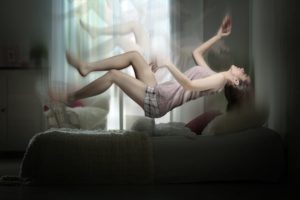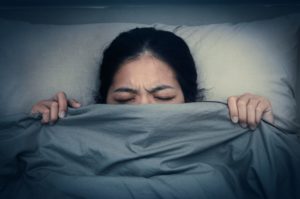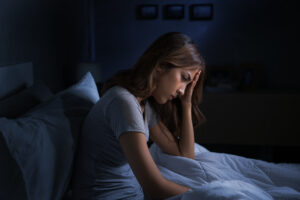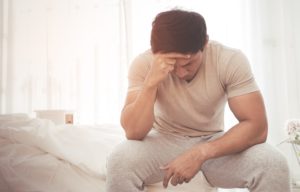What Happens if You Wake Up a Sleepwalker?
- Waking someone who’s sleepwalking isn’t inherently dangerous, but it may temporarily confuse or disorient a person, and they may not remember the incident.
- When someone sleepwalks, the safest thing to do is calmly guide them back to bed without waking, using a calm voice and gentle touch.
- If a sleepwalker is in harm’s way, it’s best to gently wake them to keep them safe.
Sleepwalking is a common parasomnia, or an abnormal behavior during sleep, that happens as a result of incomplete arousal from deep sleep. Approximately 7% of people will have a sleepwalking episode during their lifetime, and children are more likely than adults to sleepwalk .
Given the prevalence, many people likely know someone who sleepwalks. Watching a loved one sleepwalk may feel strange or startling, especially if it’s for the first time, and it can be uncertain how to react in the situation.
We take a closer look at what you should do when you encounter a sleepwalker, including whether you should wake them and how to keep them safe.
Is Your Troubled Sleep a Health Risk?
A variety of issues can cause problems sleeping. Answer three questions to understand if it’s a concern you should worry about.
Should You Wake a Sleepwalker?
As long as a sleepwalker isn’t in immediate danger, most experts agree the safest strategy is to gently redirect them back to bed without waking. That’s because a person’s brain is partly awake and partly in NREM sleep, a deep stage of slow-wave sleep, during sleepwalking . When awakened, it takes time for a sleepwalker to regain full consciousness since their brain is in “low energy mode,” says Kin M. Yuen, MD, a spokesperson for the American Academy of Sleep Medicine. This semi-conscious state can lead to disorientation and confusion.
On the other hand, if the sleepwalker is in danger of harming themselves, it’s better to wake them to keep them safe, says Angela Holliday-Bell, MD, certified sleep specialist and board-certified pediatrician. Even if the person is slightly disoriented and confused upon waking, at least they won’t get hurt.
What Happens if You Wake Up a Sleepwalker?
Sleepwalking typically occurs during deep, non-REM sleep when the brain isn’t fully alert. Specifically, the parts of the brain responsible for consciousness and cognition are in deep, slow-wave sleep while sleepwalking, says Mark Wu, MD, PhD, professor of neurology, medicine, and neuroscience at Johns Hopkins University.
When the brain is shut down in this way, it has a difficult time transitioning from a sleep state to a wake state. This explains why sleepwalkers often experience confusion, mental fog, or grogginess if woken suddenly, and why many sleepwalkers may not remember the incident.
When someone abruptly wakes from a deep sleep, they may also experience an adrenaline surge, Dr. Yuen says. This heightened state of arousal can cause disorientation, a racing heart, or sweating. “Because of this, they may appear to be startled, and their behavior may be unpredictable,” she says.
Why Is It Dangerous to Wake a Sleepwalker?
Most sleep experts agree: It’s not unsafe to wake someone who’s sleepwalking. If you choose to wake a sleepwalker, odds are, “nothing dangerous will happen,” Dr. Wu says.
However, waking a sleepwalker is not without some risk. For example, if the person becomes very confused or disoriented, they might hurt themselves trying to run away or defend themselves if they feel threatened, Dr. Wu says.
Still, the act of sleepwalking itself is often more dangerous than waking a person who sleepwalks. In fact, sleepwalking is one of the top reasons for sleep-related injury . A sleepwalker could fall down the stairs or leave the house and get hurt.
What Can You Do if Someone Is Sleepwalking?
Witnessing a partner, roommate, child, or other family member have a sleepwalking episode can be a strange and unsettling experience. But staying calm is key. Here are a few strategies to help keep both you and the sleepwalker safe.
Secure the Environment
If you have someone in your home who sleepwalks frequently, it’s best to be prepared. “Make sure windows are locked, and there are no objects on the floor they could trip on,” Dr. Wu says. “Place a bell or alarm on the bedroom door, so other people will be alert to the possibility that the individual could be sleepwalking.” If you have stairs, blocking or securing the staircase is also crucial.
Guide Them Back to Bed
Your best course of action is to get the sleepwalker back to bed safely. However, it’s important to keep yourself safe, too. Sometimes sleepwalkers, particularly men, can get aggressive or violent if someone attempts to block, grab, or restrain them during an episode.
“It’s best to gently guide them back to bed without waking them using a calm voice and light touch,” Dr. Holliday-Bell says. And if they’re in a potentially harmful situation, calmly and quietly encourage the sleepwalker away from the area that poses danger, Dr. Yuen adds.
Wake Them Only if Necessary
“If they are at risk (near stairs or doors), it’s okay to wake them, but do it gently, not with loud noises, which can cause panic,” Dr. Holliday-Bell says. “You should stay calm and quiet, gently redirect them, and block any hazards. After waking, stay nearby until they’re fully awake and alert.”
Frequently Asked Questions
Why do some people sleepwalk?
“We are not exactly sure why some people sleepwalk and others don’t, but it does tend to run in families, so there is likely a genetic component,” Dr. Holliday-Bell says. Children are also more likely to sleepwalk than adults, especially if their parents have a history of sleepwalking.
Sleep deprivation plays a role in the prevalence of sleepwalking as well
. Anything that interferes with sleep quality (untreated sleep apnea, jet lag, etc.) can also provoke sleepwalking, particularly in people with a genetic predisposition.
Other factors like stress, alcohol or drug use, certain medications, and medical conditions (such as neurodegenerative diseases) can also influence whether someone sleepwalks
. And some research has shown a possible link between sleepwalking and intense positive emotions (like excitement) or physical activity before bedtime.
What should I do if my partner sleepwalks?
When your partner sleepwalks, the goal is to keep them safe until they’re conscious and fully awake. Redirecting them back to their bed is the best option. Use a gentle voice and light touch to avoid startling them.
If your partner sleepwalks, it’s also a good idea to secure the environment to reduce the risks of injury. This may involve locking windows, safeguarding stairways, removing or securing sharp objects like knives and corners, and making sure the floor is clear of objects to prevent tripping.
Is sleepwalking dangerous for children?
Sleepwalking is not usually dangerous for children and is actually quite common. “Often, the need to use the bathroom during the night induces sleepwalking episodes [in children],” Dr. Yuen says. There’s also a theory that children sleepwalk because they spend more time in slow-wave sleep, which decreases in adulthood.
Though sleepwalking isn’t inherently harmful, and many children outgrow it, there is still the risk of injury. Locking doors and using gates can help prevent a child from wandering outside or getting hurt while sleepwalking. Depending on the child, sleeping with a sleeping bag may also be a helpful deterrent to sleepwalking.
Lastly, if your child sleepwalks and also snores, they might be dealing with another underlying condition such as sleep apnea. Consult with your pediatrician, who may refer you to a pediatric sleep specialist for a further evaluation.

Still have questions? Ask our community!
Join our Sleep Care Community — a trusted hub of sleep health professionals, product specialists, and people just like you. Whether you need expert sleep advice for your insomnia or you’re searching for the perfect mattress, we’ve got you covered. Get personalized guidance from the experts who know sleep best.
References
5 Sources
-
Stallman, H. M., & Kohler, M. (2016). Prevalence of Sleepwalking: A Systematic Review and Meta-Analysis. PloS one, 11(11), e0164769.
https://pubmed.ncbi.nlm.nih.gov/27832078/ -
Lopez, R., Jaussent, I., Scholz, S., Bayard, S., Montplaisir, J., & Dauvilliers, Y. (2013). Functional impairment in adult sleepwalkers: a case-control study. Sleep, 36(3), 345–351.
https://pubmed.ncbi.nlm.nih.gov/23450499/ -
Zadra A, Desautels A, Petit D, Montplaisir J. Somnambulism: clinical aspects and pathophysiological hypotheses. Lancet Neurol. 2013;12(3):285-294. doi:10.1016/S1474-4422(12)70322-8
https://pubmed.ncbi.nlm.nih.gov/23415568/ -
Zadra A, Pilon M, Montplaisir J. Polysomnographic diagnosis of sleepwalking: effects of sleep deprivation. Ann Neurol. 2008;63(4):513-519. doi:10.1002/ana.21339
https://pubmed.ncbi.nlm.nih.gov/18351640/ -
Bušková, J., Piško, J., Pastorek, L., & Šonka, K. (2015). The course and character of sleepwalking in adulthood: a clinical and polysomnographic study. Behavioral sleep medicine, 13(2), 169–177.
http://www.tandfonline.com/doi/abs/10.1080/15402002.2013.845783















